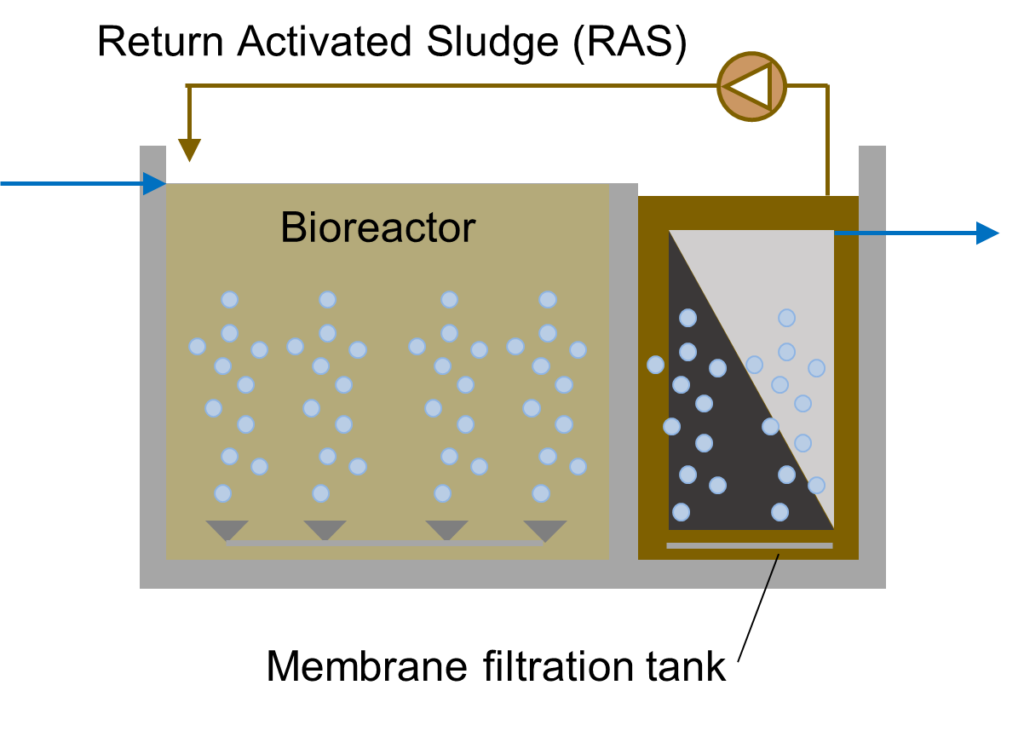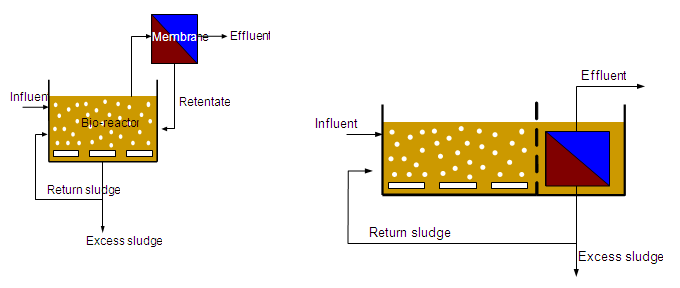Exactly How Membrane Bioreactors Are Changing Water Filtration Solutions
The appearance of membrane bioreactors (MBRs) represents a considerable development in the area of water filtration, merging organic therapy processes with cutting-edge membrane layer purification innovations. This assimilation not just improves the high quality of treated effluent yet also addresses city space restrictions, making MBRs particularly suitable for largely inhabited locations. As global water deficiency escalates, the duty of MBRs in helping with drinkable water reuse and lasting water monitoring comes to be increasingly essential. Yet, the effects of this innovation expand past performance-- what challenges and possibilities exist in advance for its extensive execution?
Overview of Membrane Bioreactors
Membrane bioreactors (MBRs) stand for a significant advancement in water purification technology, as they combine organic treatment processes with membrane layer filtration. This integration boosts the performance of wastewater treatment by using microorganisms to deteriorate natural contaminants while at the same time utilizing semi-permeable membrane layers to separate treated water from put on hold virus and solids.
The MBR system typically includes a biological activator where the microbial populace metabolizes pollutants, adhered to by a membrane layer filtering unit that keeps biomass and allows just tidy water to go through. This dual performance leads to greater effluent high quality contrasted to traditional therapy approaches. MBRs can be run in both set and continuous flow settings, providing adaptability in style and application.
They likewise allow the recovery of water for reuse, thus adding to water sustainability campaigns. On the whole, MBRs are at the center of enhancing water treatment effectiveness and high quality, showcasing the possibility for cutting-edge remedies in environmental administration.
Benefits of MBR Innovation
The integration of biological treatment with membrane filtering offers various benefits for water purification processes. One of the main advantages of Membrane layer Bioreactor (MBR) technology is its ability to efficiently eliminate both organic and not natural contaminants, bring about premium effluent. The membranes function as a physical barrier, protecting against put on hold solids and virus from going through, which enhances the total security and dependability of treated water.
Furthermore, MBR systems require a smaller impact compared to traditional treatment approaches, enabling for a lot more effective room utilization. This small design is particularly beneficial in city setups where land is restricted. MBRs likewise demonstrate functional flexibility, accommodating varying influent high qualities and flow rates without considerable performance deterioration.
Furthermore, the procedure uses boosted nutrient removal capabilities, particularly for nitrogen and phosphorus, which are essential for preventing eutrophication in obtaining waters. The reduced sludge manufacturing connected with MBR innovation additionally converts to decrease disposal costs, making it a cost-effective option in the long run - Membrane Bioreactor. In general, the benefits of MBR innovation placement it as a leading option for lasting and ingenious water purification systems, addressing both environmental and economic worries
Applications in Water Filtration
Applications of Membrane Bioreactor (MBR) technology in water filtration are impactful and diverse, addressing various treatment needs throughout numerous fields. MBRs effectively incorporate organic therapy processes with membrane layer purification, making them ideal for community wastewater therapy, industrial effluent administration, and also safe and clean water reuse campaigns.
In municipal settings, MBRs are increasingly employed to improve the high quality of treated wastewater, permitting conformity with stringent discharge policies and helping with the recycling of water for watering and non-potable usages. Their portable layout likewise makes them ideal for metropolitan settings where area is restricted.
Industrially, MBR technology is used to treat process water and wastewater, specifically in markets such as food and beverage, drugs, and textiles. By effectively removing contaminants and put on hold solids, MBRs help markets decrease environmental effects while recovering useful sources from wastewater streams.
Moreover, MBRs are acquiring traction in decentralized water therapy applications, where small systems can be released in remote areas or developing areas. This adaptability makes it possible for areas to achieve lasting water management solutions, boosting accessibility to clean water while reducing reliance on standard therapy techniques.
Instance Studies and Success Stories

In another instance, a textile manufacturing facility in Bangladesh adopted MBR innovation to address its wastewater challenges. The system minimized chemical oxygen need (COD) degrees from 1,200 mg/L to much less than 100 mg/L, hence satisfying regulative requirements and dramatically lessening ecological influence.
The University of Cape Community's MBR installment has actually verified effective in treating greywater for non-potable reuse on university. This task not only preserves potable water but additionally serves as an instructional model for lasting practices.
Furthermore, a fish and shellfish handling plant in Norway utilized MBR modern technology to deal with effluents having high degrees of raw material, achieving over 90% pollutant elimination. These study emphasize MBR modern technology's convenience and its vital function in enhancing water quality across diverse applications.
Future of Water Treatment Solutions
As global water deficiency and pollution challenges increase, innovative water therapy remedies are coming to be increasingly important to guarantee sustainable access to clean water. The future of water therapy lies in the integration of innovative innovations that enhance the performance and performance of filtration processes. Membrane bioreactors (MBRs) go to the forefront of this advancement, incorporating biological therapy with membrane filtering to produce top quality effluent appropriate for various applications.

Emerging fads such as resource recuperation from wastewater, including nutrients and energy, will additionally change therapy centers right into click here for more info eco-friendly centers. Innovations in nanotechnology and membrane materials assure improved efficiency and long life of filtering systems.

Conclusion
To conclude, membrane bioreactors represent a considerable innovation in water filtration technologies, properly integrating biological therapy with sophisticated membrane layer filtration. The numerous advantages, including enhanced effluent quality and decreased spatial requirements, make MBRs particularly appropriate for metropolitan applications. Their function in safe and clean water reuse and lasting water administration highlights their importance in addressing global water shortage obstacles. Proceeded research and advancement will certainly even more enhance the effectiveness and adoption of MBR innovation, making certain a durable future for water treatment services.
The introduction of membrane layer bioreactors (MBRs) stands for a significant improvement in the field of water purification, merging biological treatment procedures go to this site with cutting-edge membrane layer filtering technologies. As worldwide water deficiency magnifies, the function of MBRs in promoting drinkable water reuse and lasting water management ends up being progressively crucial. They likewise allow the recovery of water for reuse, therefore contributing to water sustainability efforts.As international water deficiency and pollution challenges magnify, ingenious water therapy options are becoming increasingly important to make sure sustainable access to tidy water. Their role in potable water reuse and sustainable water management highlights their importance in dealing with international water scarcity difficulties.
Comments on “How Membrane Bioreactor Can Help Meet Stringent Environmental Regulations”